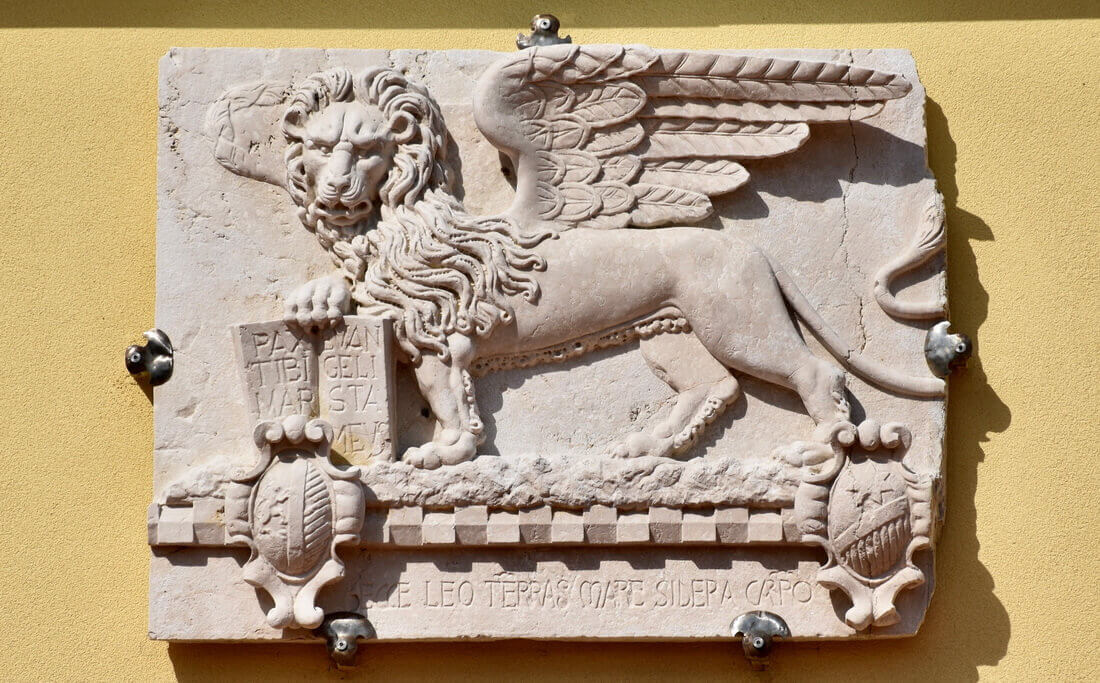
What is the famous inscription in the Book of the Lion of San Marco?
The Lion of San Marco immediately brings Venice to mind. It has no official or political meaning, but a popular and religious origin. It is the symbolic representation of St Mark the Evangelist, protector saint of the city, and the Latin inscription on the book, which the lion holds open with its paw, corresponds to the first solemn words that, according to an ancient legend, an angel spoke to him during an apparition in Venice:
“Pax tibi Marce Evangelista meus, hic requiescet corpus tuum”.
(Peace be with you Mark my Evangelist, here shall your body rest).
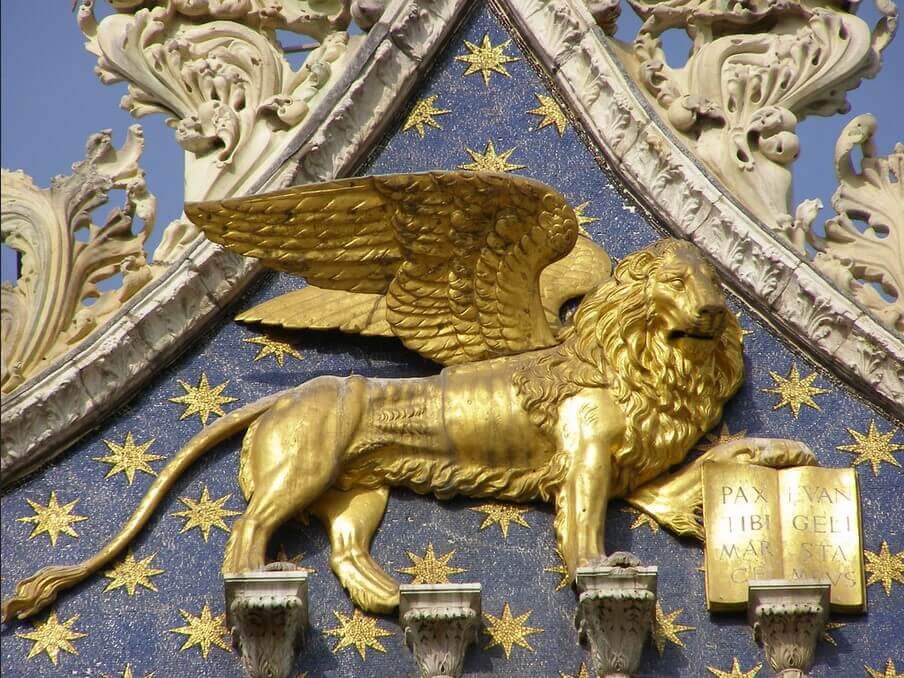
Winged golden lion – Basilica of Saint Mark, Venice
In other articles of our blog, we have narrated the legend of San Marco and the Angel, and described the meaning of the symbolism associated with the Lion of San Marco, which over time has become a symbol of the lagoon city, the Serenissima Republic of Venice, the Municipality, the Province and the Region of Veneto.
Cover photo: highrelief of the Lion of San Marco – Arte 2000 work
Sculptures of St. Mark’s Lion with the most famous phrase on the book
When creating sculptures of St. Mark’s Lion, we usually use the most famous and well-known phrase «Pax tibi Marce Evangelista meus» on 8 lines.
These are some of our works:
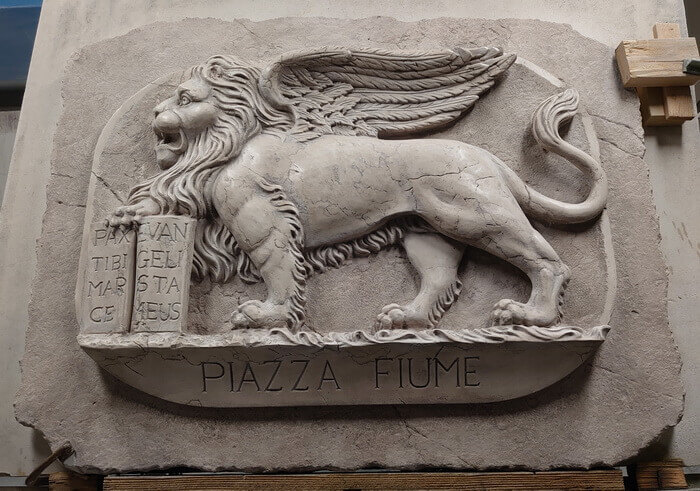
Arte 2000 work
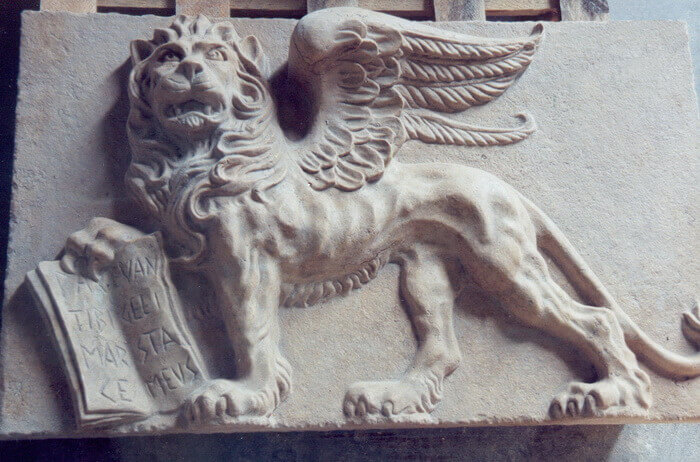
Arte 2000 work
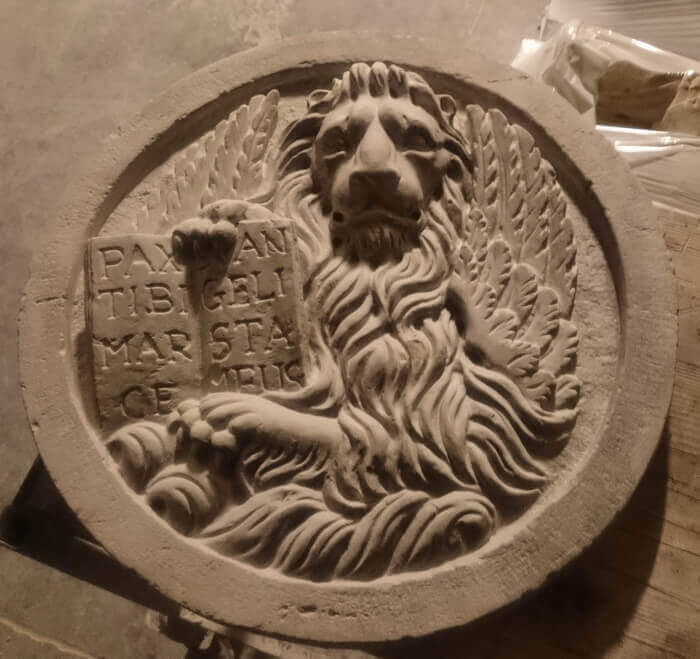
Arte 2000 work
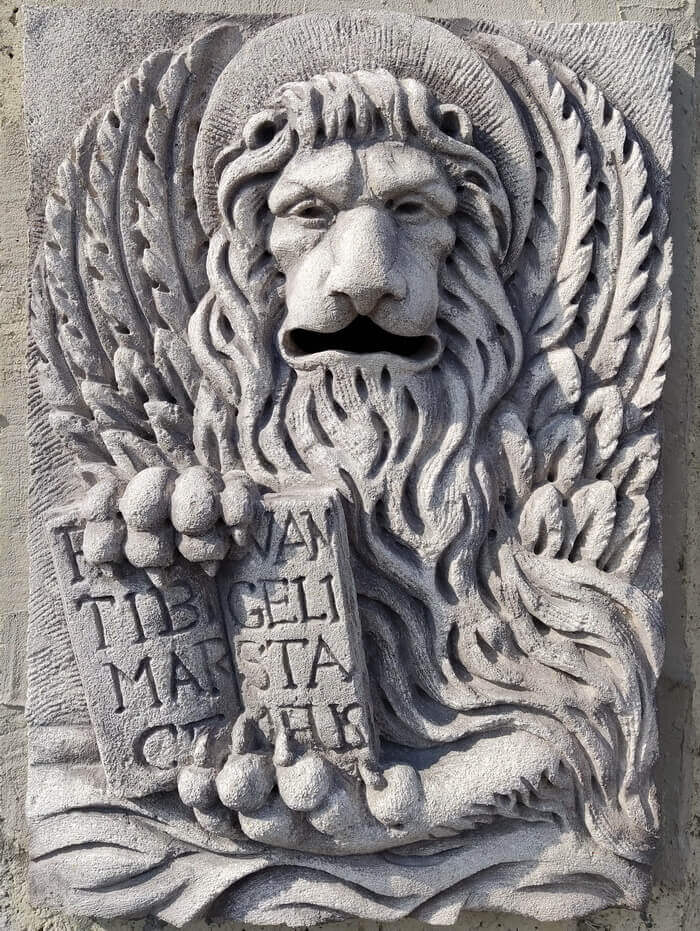
Arte 2000 work
Famous phrases in the book of the Lion of San Marco
Throughout the centuries and in the various countries of Istria, Fiume and Dalmatia, the Aegean islands and the many other territories of the Republic of Venice, different and alternative inscriptions have been used in the open book of the different representations of the Lion of San Marco, not least in order to preserve a historical and cultural identity.
Here are some of the phrases used in famous and important works:
- the most classic and famous inscription is undoubtedly «Pax tibi Marce Evangelista meus», spread over a total of 8 lines, four on each side of the book: «PAX / TIBI / MAR / CE E / VAN / GELI / STA / MEVS». Among the most famous works are:
- the winged lion by Vittore Carpaccio, exhibited in the Doge’s Palace in Venice;
- the painting by Cima da Conegliano;

Lion of St. Mark – Vittore-Carpaccio work – Doge Palace

Lion of San Marco – Cima da Conegliano work
- sometimes, although more rarely, the same phrase in 6 lines, three on each side of the book: ‘PAX / TIBI / MARCE / EVANGE /LISTA /MEVS’. One of his most famous works is the winged lion on the façade of the Scuola Grande;
- another famous quotation is ‘LINQUITUR / HIC ODIUM / METUS O(MN)IS / ZELUS ET A(R)DOR / PLECTITUR HIC / QUAE SCELUS LI / BRATUM CU / SPIDE VERI’ (Here hatred, all jealousy and impetuosity are left aside, here the crime is punished by balancing it on the needle of truth). It appears in the artistic work painted by Jacobello Del Fiore in 1415 and exhibited in the Grimani Hall of the Doge’s Palace in Venice. This work depicting a marching Lion, facing left and nimbed became the inspiration for the flag of the Veneto Region;
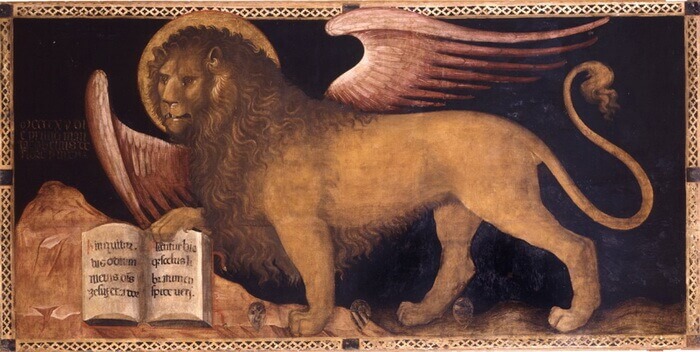
Lion of St. Mark – Jacobello Del Fiore work, Palace of Doge – Venice
- another very long sentence is ‘Scdum Marcum: ecce Ego mitto aglm meu an facie tuam qu pparavit via tua an te’ (‘Secumdum Marcum: ecce Ego mitto angelum ante faciem tuam qui preparavit viam tuam ante te’ and in Italian: ‘From the Gospel according to Mark: Behold, I send my messenger before you, who will prepare your way before you’), quoted in the high relief of the Lion of St Mark, which was attached to Pula’s Marina Gate and taken as spoils of war by the Genoese militia in the second half of the 14th century, when they subjected all the coastal towns of the Istrian peninsula to fire and sword. Today it is walled up in St Mark’s Church on the quay in Genoa.
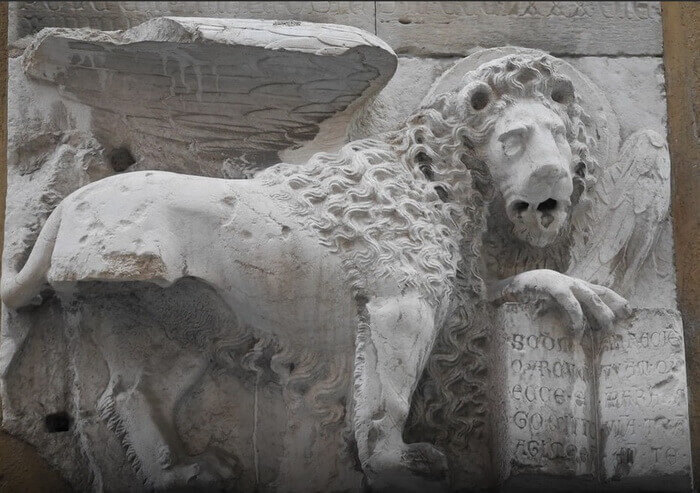
Highrelief Lion of St. Mark fixed to the Porta Marina, Pola – Istria
Another peculiar phrase is that of the Piran high relief, where the phrase appears under the lion: «Alliger ecce leo / ter(r)as mare sidera carpo» (Behold, I, the winged lion, walk the spaces of land, sea and stars). In this work, the book is unwritten and the advancing lion appears to be suspended in mid-air, its head tilted to the left and its claws very pronounced.
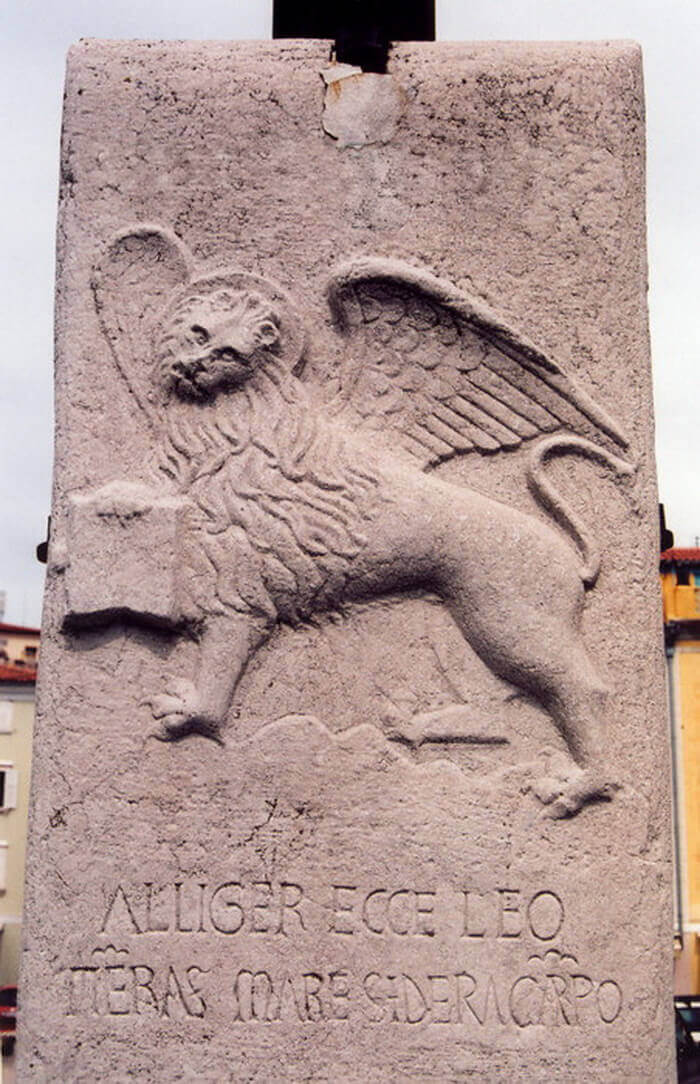
Lion of St. Mark – Pirano, Istria
Although it is illegible today, the same phrase seems to have been engraved on the bas-relief of the Lion of San Marco, which is currently on the Clock Tower in Rovinj.
What are the Scuole Grandi?
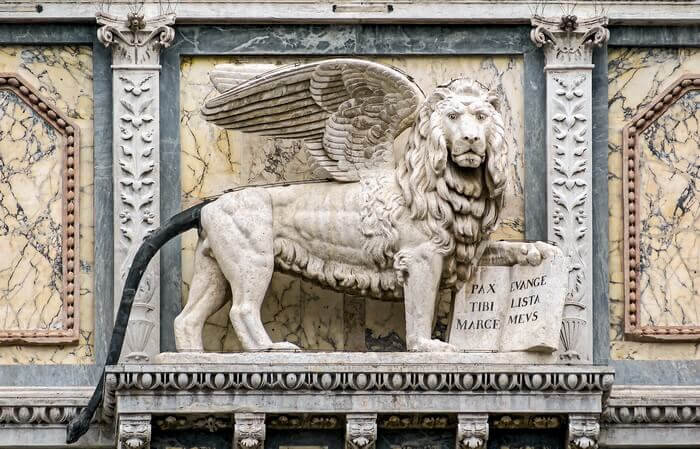
Lion of St. Mark sculpture – Scuola Grande of San Marco façade
The Scuole, which originated in Venice in the 13th century, were lay-managed associations of citizens dedicated to the devotion of a saint, a profession such as stonemasonry, or a trade, or fraternities of foreigners of non-Venetian origin. Some Schools gradually grew in importance due to the number of members, social interest and the availability of large capitals, splendid venues and sumptuous furnishings for city events, and in 1467 they were recognised as Scuole Grandi (Great Schools), thus distinguishing them from the others known as Scuole Piccole (Small Schools). St Mark’s was one of the first Scuole Grandi. Between the 15th and 16th centuries, they developed into public institutions of assistance and control in social life.
The inscription on the open book of the winged lion can therefore have infinite nuances; there is no doubt as to which one to use in the case of the closed book, which has no inscription.
Here are some of our works:
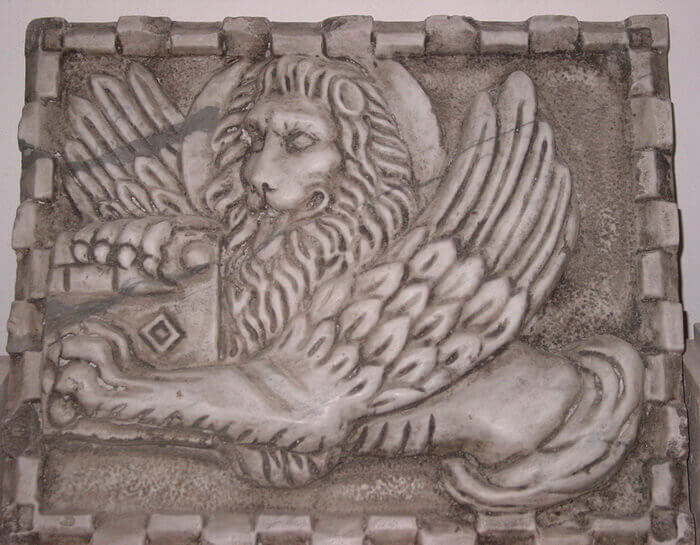
Basrelief Leone of St. Mark in marble with antique finishing – Arte 2000 work

Basrelief Leone of St. Mark in marble with antique finishing – Arte 2000 work
This article contains general information. For questions and curiosities leave a comment below. If you wish to be contacted, please fill out the form.



EDmundo
2 June 2025 at 16:42Tibi pax mar ce , Van geli Sta mens
dit is wat ik las eerste instantie
Vrede zij met uw Marcus, waar jij wordt geboren is tegelijk jouw laatste rustplaat
Arte 2000 - Paola
22 July 2025 at 11:42Exactly,
I thank you for your attention and appreciation of our blog.
Best regards. Paola